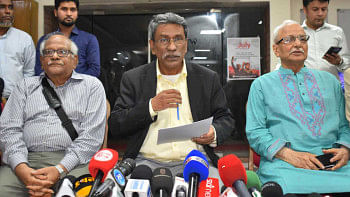A riverine horror show

In mid-March, a report by this daily highlighted the findings of a study by the Rivers and Delta Research Centre (RDRC) that said that 56 rivers across the country are suffering from extreme pollution. It was an alarming if not entirely shocking revelation. But new details of the year-long study, courtesy of a recent BBC report, throw further light on the scale of the damage being wrought, which makes one sit up and take notice. Apparently, key pollutants including microplastics have been found in all the rivers surveyed, meaning that industrial and municipal wastes dumped in rivers near cities and towns are flowing into rivers in far-flung coastal areas.
Which, in other words, means that if preventive steps are not taken, the pollution of these rivers will affect all other rivers as well.
Another important revelation is about three rivers which have been identified as the most polluted. These are Labandaha in Gazipur, Haridhowa in Narshingdi, and Sutang in Sylhet. Of them, the Labandaha river, once called "Labalong Sea" because of its size, has now been reduced to a canal through constant pollution and encroachment. Some 250 factories have been found on the banks of this river, and industrial waste generated by them, together with waste from the Sripur municipality, are all dumped in the river, choking it to death. The same thing is happening to Haridhowa, which was once used for fishing and agricultural purposes but is now little more than a dumping ground. The story of Sutang, a cross-border river in Sylhet, is no different; so polluted has its water become that it is no longer distinguishable as a river.
Plastic waste, household waste and industrial waste are all landing, untreated and unopposed, in these rivers and others, robbing them of their life. The question is, why are we allowing this to happen? A more worrying question is, are these rivers damaged irreversibly? Only the other day, the shipping minister warned that Bangladesh will not survive if our rivers stop flowing. Studies like the one by RDRC suggest that we may already be headed in that direction. Our country is a victim of not just negligent handling of its wastes by individuals and institutions but also of a development/urbanisation policy that pays little heed to environmental concerns. Industries and EPZs are being built near rivers. Tanneries are being relocated near rivers. Urban authorities are using them as garbage dumps.
How long can our rivers, or Bangladesh as we know it, survive in such an environment?
Because of unchecked pollution, not only are the ecosystems of rivers being damaged, but the lives and livelihoods of people living near rivers, as well as our agriculture, public health and sources of clean water are also being threatened. Such catastrophic mismanagement can no longer continue. We urge the authorities to take stern actions in this regard.

 For all latest news, follow The Daily Star's Google News channel.
For all latest news, follow The Daily Star's Google News channel. 









Comments